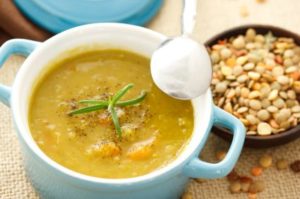Summer is changing into Fall, and Ayurveda suggests that we should change, too. This 5,000-year-old science of health and healing makes lifestyle and dietary recommendations according to the season. Each season has particular qualities, and the way these qualities are combined and balanced define that season’s dosha. There are three doshas: vata (air, movement), pitta (fire, heat, transformation), and kapha (structure, density, cohesion). It is recommended that we eat foods that have the opposite qualities of the dominant seasonal dosha.
In this phase—late summer, entering fall—Vata is the dominant energy. The attributes of Vata are cool, dry, light, rough, clear, and mobile. To balance out these qualities, we can eat foods that carry the opposite attributes: warm, heavy, moist, oily, stable, cloudy, and dense. Stews, soups, rice, barley—easy-to-digest, mushy foods.
On a recent Sunday morning, I promised our Union Square students that I would share a recipe for kitchari. Kitchari (kitchadi, kitcheri) is a classic Ayurvedic dish. It is considered tridoshic, meaning it is suitable for all individual constitutions. It is basic yet highly nourishing, made with mung dal, basmati rice, vegetables, and assorted spices. It can have healing, grounding, stabilizing, and detoxifying effects, especially during the change from summer to fall.
Visit Banyan Botanicals for more information on doshas and kitchari.
This kitchadi recipe is from my friend and one of my first yoga teachers, Lisa Schrempp. Lisa will be teaching an Ayurveda and Ashtanga workshops at The Shala on March 23-25, 2018! Save the date!
2 Tbs ghee or another high heat oil
1 tsp cumin seeds
1 tsp mustard seeds
1/2 tsp fenugreek seeds
1/4 tsp black peppercorns
1/4 tsp pippali (long pepper)
1/4 tsp fennel powder
1/4 tsp coriander powder
2 pinches asafetida
1 tsp turmeric powder
1 tsp grated ginger root
1/4 tsp grated turmeric root
6 cups water
1 cup split mung dal
1 cup rice (white or brown basmati) or quinoa
1 cup chopped veggies of your choice
1/2 cup chopped cilantro
1/2 cup shredded coconut
1 lime quartered
1/2 tsp salt (add in 5 minutes before serving, not at beginning)
Soak the mung dal one half an hour for split and two hours for whole. Wash the rice and mung well. Melt ghee or heat oil in pan and add all of the dry seeds, not powders. Wait a minute or two until they will pop. Turn down the heat. Add all powders and salt. Add the ginger and turmeric roots. After mixing add rice and mung. Stir well and coat the beans and rice with ghee and spices. Sauté a minute and then add 6 cups water (can add more water if you want it more soupy). Bring to a boil for a couple of minutes. Then turn down to low heat and add veggies. Put lid on pot and cook until all water is absorbed, about 15 minutes. Top with cilantro leaves, shredded coconut, and squeeze of lime.
You can alter this by making it with brown rice and whole green mung. This will then take near to 45 minutes to cook and you may want to add veggies last twenty minutes. You can also use quinoa instead of white basmati. It takes the same shorter time with the split mung and is a great grain for the spring. Alter with different spices and veggies. This one recipe can provide many delicious, quick, easy, and very healthy meals.
photo of Lisa Schrempp
— posted by barbara verrochi

